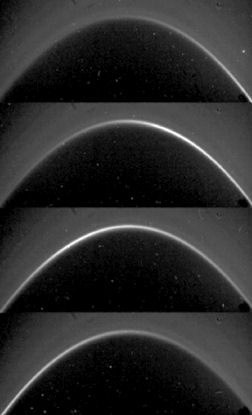G Whiz! Craft identifies source of faint Saturnian ring
Among Saturn’s shimmering ice belts, the planet’s G ring has proved the most puzzling. The very location of this faint, narrow ring, well beyond the planet’s main ring system, has been a riddle ever since the two Voyager spacecraft spied it in 1980. The G ring lies more than 15,000 kilometers from any Saturnian moon. It’s neither flanked by bodies that might corral its particles, as the moons Pandora and Prometheus do for the F ring, nor close to an object that could shed particles to populate the ring, as Enceladus does for the E ring.

Now, in one fell swoop, the Saturn-touring Cassini spacecraft has discovered the source of the G ring and identified the body whose gravity holds the source material together.
Cassini images taken in 2004 and 2005 showed a bright arc just inside the G ring. The 250-km-wide crescent is about one-twentieth the width of the G ring, report Matt Hedman of Cornell University and his colleagues in the Aug. 3 Science.
When micrometeoroids that rain down on Saturn smash into the arc, they raise clouds of smaller, more reflective ice particles that keep the structure bright. Highly ionized gas entrained by Saturn’s magnetic field sweeps through the region and drags the particles out of the arc, feeding them into the G ring, Hedman’s team suggests.
Analysis of the Cassini images of the arc revealed the presence only of minute particles like those that constitute smoke. These tiny grains are easily dispersed, and wouldn’t remain in the ring for more than several thousand years. But measurements taken around the same time by another Cassini instrument indicate that the arc also contains pea-size to boulder-size ice chunks, which can stick around longer.
Those measurements recorded a low density of energetic electrons in the arc’s vicinity. The sparse population of small particles in the arc can’t account for this depletion, leading the researchers to conclude that the arc also has an abundant population of larger particles.
The team found that the arc orbits Saturn seven times for every six orbits of the moon Mimas, which is about 20,000 km from the ring. Called a corotational resonance, this gravitational relationship suggests that Mimas keeps the arc intact, allowing it to feed the G ring, Hedman says. Arcs around Neptune have similar resonances with its moons, but those relationships don’t appear to fully account for the sizes of the arcs.
The Cassini findings “are not just answering one question, but two,” comments planetary scientist Mark Showalter of the SETI Institute in Mountain View, Calif. “We finally know the source of the G ring, and we now have a really good example of co-rotational resonance in action.”







